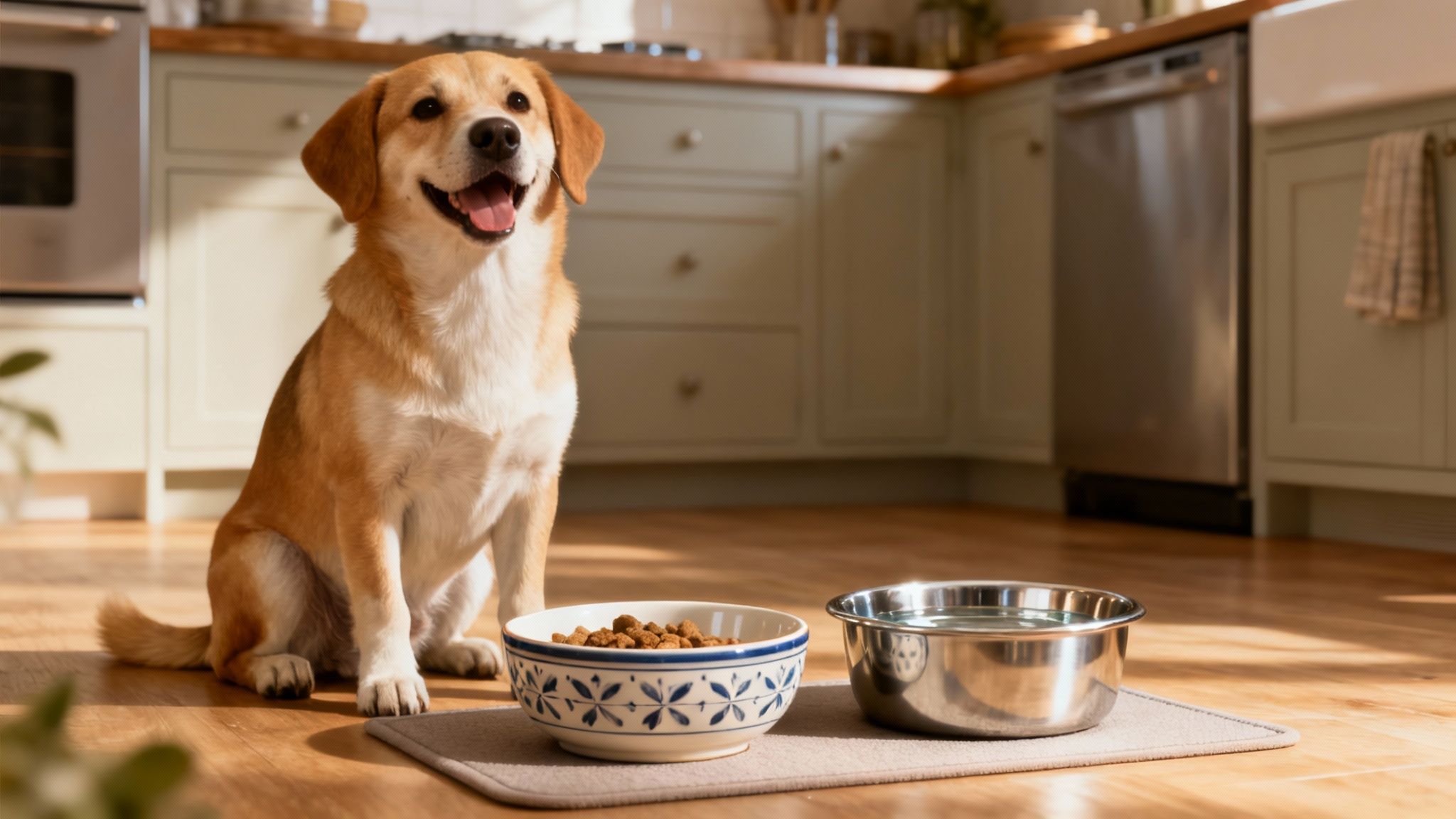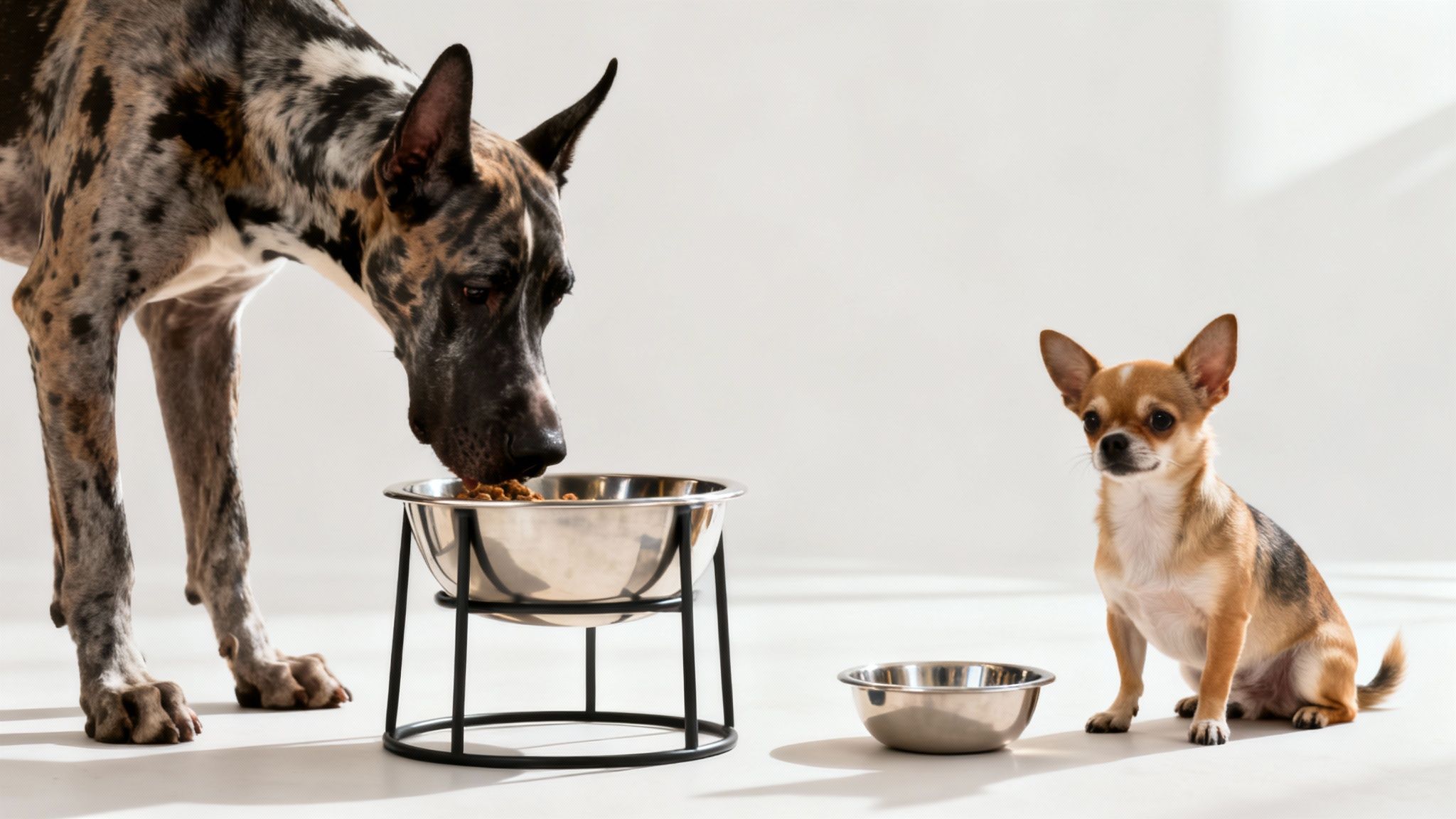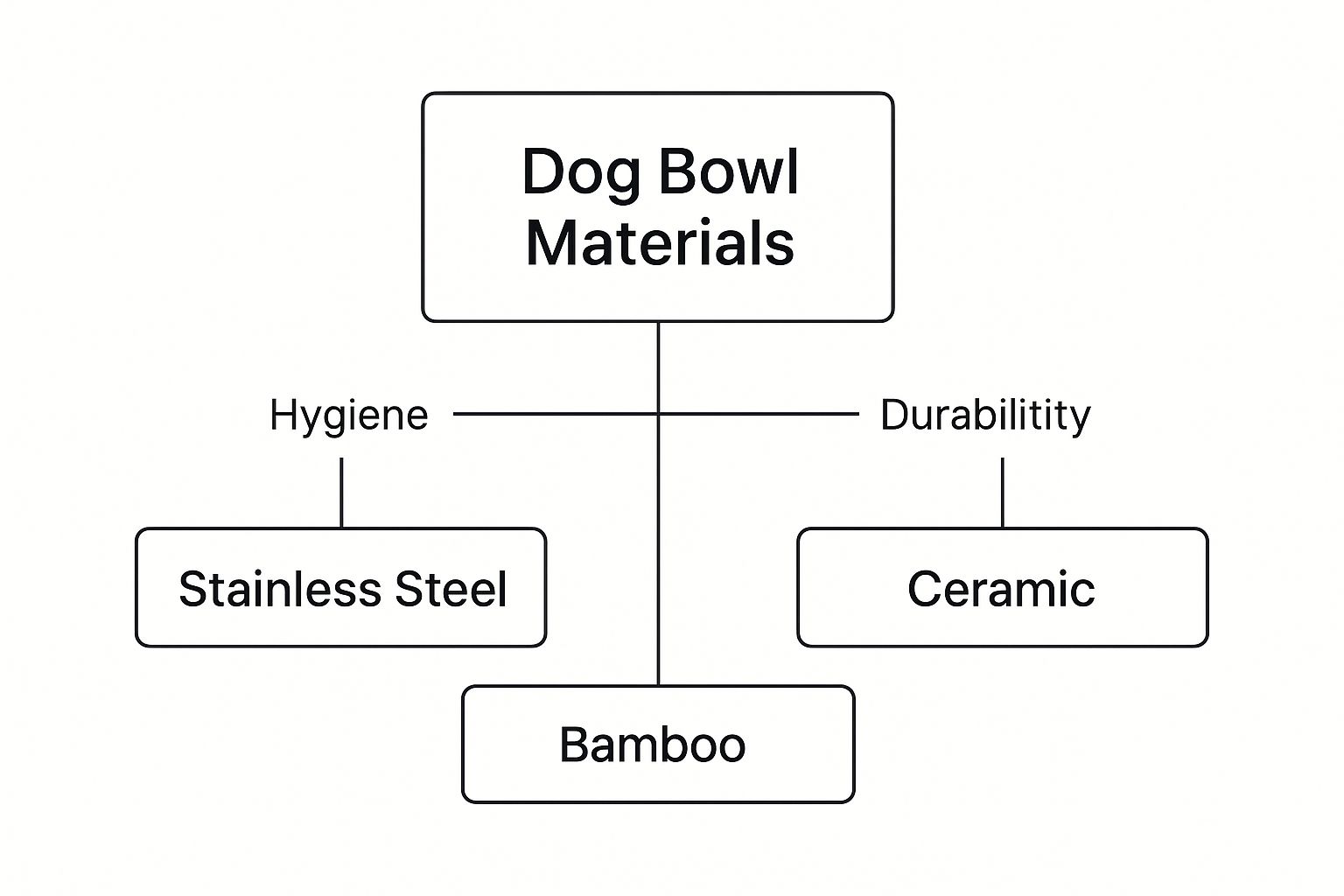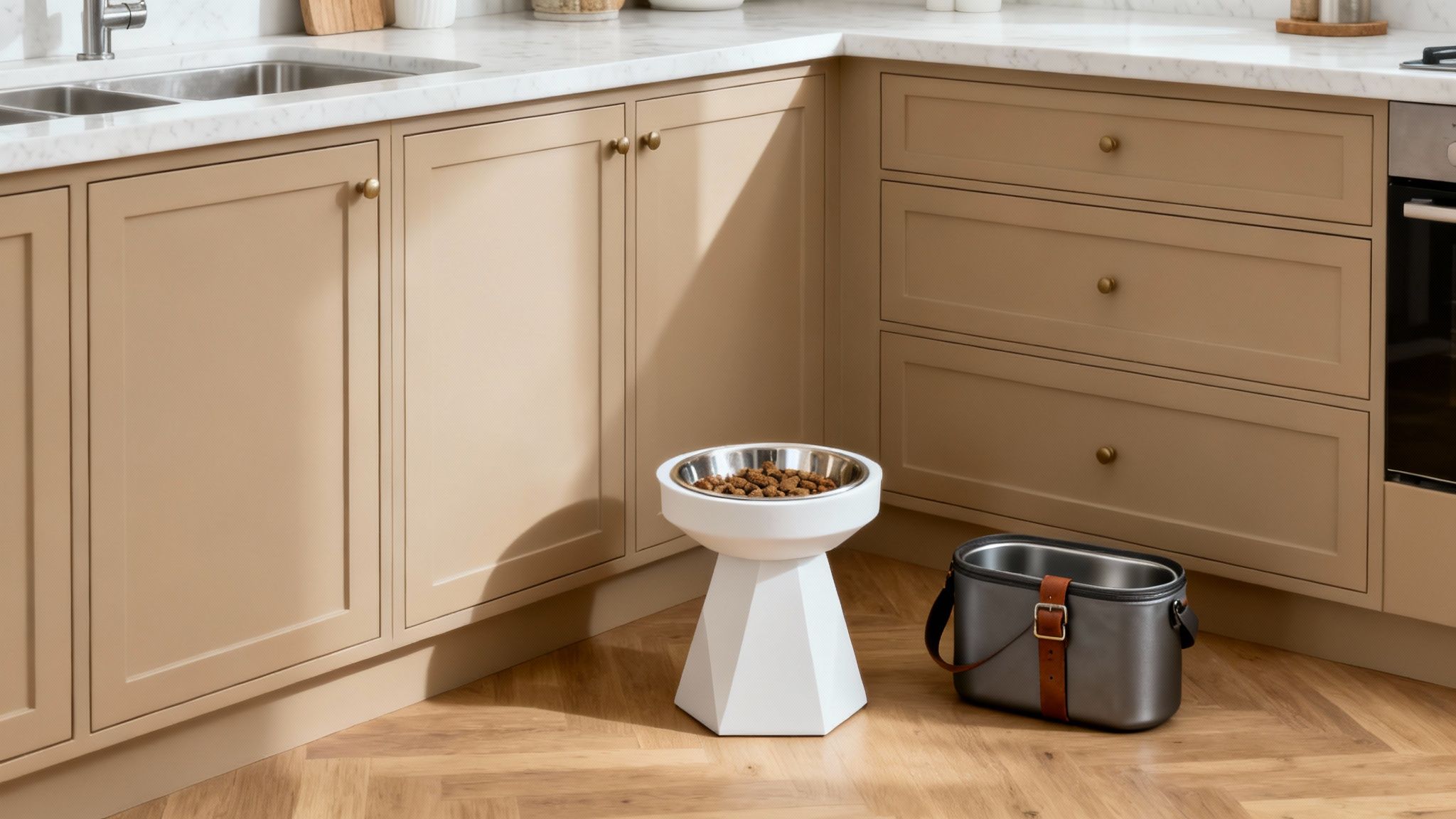
Choosing the Best Ciotole per Cani for Your Dog's Wellness
Share
It's easy to overlook something as simple as your dog's food bowl, but choosing the right one is so much more than a routine purchase. Think of it as a small, daily act of love that plays a huge part in your dog's overall wellbeing. This decision touches everything from their digestion and posture to their overall mealtime happiness.
More Than a Dish, It's Part of Your Kitchen Décor

Welcome to our guide on finding the perfect ciotole per cani. While it might seem like just another kitchen utensil, the right bowl can genuinely support your best friend's health. The wrong one? It could lead to anything from discomfort to more serious health risks.
Imagine choosing your own dinner plates or cutlery. You’d want something that's safe, easy to clean, and fits the aesthetic of your dining room. Your dog's bowl is the centrepiece of their dining experience, a crucial kitchen tool that contributes to their "mealtime wellness."
This idea is all about seeing feeding time as more than just nutrition. It's a joyful ritual that promotes good health. A thoughtfully chosen bowl isn't just a purchase; it's an investment in your dog's happiness and a seamless addition to your home's kitchen design.
Choosing a dog bowl is an opportunity to show you care. It’s a daily gesture that enhances your pet’s comfort, promotes better eating habits, and strengthens the bond you share.
By looking beyond the basics, you can find a bowl that truly fits your dog’s unique needs. Let's get you inspired to:
- Prevent health issues: Learn how different materials and designs can stop nasty bacteria and improve digestion.
- Encourage good habits: Find special bowls that help fast eaters slow down or make dining more comfortable for older dogs.
- Enhance your home: Discover a design that looks beautiful in your kitchen and reflects your personal interior design style.
If you're curious about other ways to build a stylish and pet-friendly space, you might enjoy our latest articles and guides on home essentials.
Decoding Your Dog’s Unique Needs

Before you dive into the sea of materials and styles, the very first step is to simply look at your dog. Really look at them. Every single one of our furry friends is a world unto themselves, and the perfect ciotole per cani (dog bowls) should feel like it was made just for them, supporting their health and happiness with every bite.
Think of yourself as a loving detective, piecing together clues about your dog's wellbeing. It’s obvious that a tiny Chihuahua and a towering Great Dane live in different worlds, and so their bowls should be different, too. The same goes for a bouncy, growing puppy versus a wise old senior who needs a bit more comfort.
This desire to give our pets the best is deeply felt here. Italy has one of the highest pet ownership rates in Europe, with almost 60% of households sharing their lives with at least one pet. This incredible bond has naturally led to a demand for better, more thoughtful feeding solutions for the nation's estimated 7 million dogs. You can read more about Italy’s booming pet care world over at PetfoodIndustry.com.
Consider Your Dog's Size and Breed
The most straightforward starting point is your dog’s size. The bowl needs to be proportionate, not just for looks, but to ensure they can eat comfortably and maintain good posture. Forcing a large dog to stoop over a bowl on the kitchen floor can strain their neck, just as a deep bowl can feel like an impossible puzzle for a flat-faced breed like a Pug or a French Bulldog.
Here’s a quick breakdown:
- Small Breeds: Look for shallow bowls. This prevents their sensitive whiskers from constantly brushing against the sides and gives them easy access.
- Large Breeds: These gentle giants often do much better with elevated bowls, which reduce neck strain and can even help with digestion.
- Flat-Faced Breeds: Tilted, shallow, and wide bowls are a must. They allow your dog to eat without squashing their face against the sides.
Your dog's bowl should be a bridge, not a barrier, to their food. The goal is to make every meal an easy, comfortable, and positive experience.
Age and Eating Habits Matter
Your dog's age and unique personality are just as important. Do you have a clumsy, enthusiastic puppy who sends lightweight bowls flying across the kitchen floor? A heavier ceramic or stainless steel option might be the perfect solution.
Pay attention to how your dog eats. If they inhale their food in the blink of an eye, a slow-feeder bowl with its built-in nooks and crannies is a brilliant way to slow them down, preventing bloating and aiding digestion. For older dogs dealing with the aches of arthritis, an elevated bowl can be a true gift, transforming mealtimes from a painful chore into a pleasant experience.
As you create a safe and comfortable home for them, you might also find a pet safety gate useful for keeping them secure and out of harm's way.
A Practical Guide to Dog Bowl Materials
Choosing the material for your dog's bowl is more than just a simple purchase; it’s a decision that directly impacts their health and your peace of mind. Think of it this way: the bowl that holds their food and water can either be a clean, safe vessel or a hidden source of trouble. This is your chance to give your best friend the very best.
The ideal ciotole per cani should be tough, completely safe, and a breeze to keep clean. It’s a lot like picking out cookware for your own family. You’d want something non-toxic, built to last, and easy to wash, right? The same logic applies here, ensuring every meal is a healthy one.
This infographic breaks down the key benefits of three popular materials, showing how stainless steel is tied to hygiene, ceramic to stability, and bamboo to sustainability.

As you can see, the choice you make often reflects what you value most—whether that’s pristine cleanliness, something that will last for years, or making an eco-friendly statement.
Exploring the Top Material Choices
When you’re weighing up the options, think about your daily life. Is the bowl going to survive the playful nudges of a growing puppy? Can you pop it in the dishwasher for a quick and easy clean after a particularly sloppy dinner? The best material is one that fits seamlessly into your household routine while keeping your dog safe and sound.
Let's dive into the most common contenders:
- Stainless Steel: This is the gold standard for a reason. Vets often recommend stainless steel because it's the champion of hygiene. It’s non-porous, which means nasty bacteria have nowhere to hide. Plus, it’s incredibly durable and ridiculously easy to clean.
- Ceramic: A beautiful and classic choice, ceramic bowls can add a splash of style to your home. High-quality, lead-free ceramic is heavy, making it stable and hard to tip over. The only catch? You need to check them regularly for any chips or cracks where germs could gather.
- Plastic: While cheap and lightweight, plastic is generally the one to avoid. It scratches far too easily, creating the perfect breeding ground for bacteria. Worse still, some plastics can contain harmful chemicals like BPA that could leach into your dog's food.
- Eco-Friendly Options: Materials like bamboo are becoming more and more popular. They’re a fantastic, sustainable, and lightweight alternative, but it's crucial to make sure they are made from 100% food-grade and pet-safe materials.
Your pet's bowl is more than just a dish; it is a guardian of their health. Selecting a non-porous and easily sanitised material is one of the most significant contributions you can make to their daily wellness.
Dog Bowl Material Comparison
To make things even clearer, here’s a quick comparison to help you see the pros and cons of each material at a glance.
| Material | Pros | Cons | Best For |
|---|---|---|---|
| Stainless Steel | Durable, non-porous (hygienic), dishwasher-safe, unbreakable | Can be noisy, lightweight options might slide around | Pet owners prioritising hygiene and durability; great for all dogs. |
| Ceramic | Heavy and stable, stylish designs, easy to clean | Can chip or crack (harbouring bacteria), can contain lead if low-quality | Calm eaters and owners who want a stylish bowl that won't tip over. |
| Plastic | Inexpensive, lightweight, comes in many colours | Scratches easily (traps bacteria), may contain harmful chemicals (BPA) | Not generally recommended, but could be a temporary or travel option. |
| Bamboo | Eco-friendly, lightweight, often stylish | Durability can vary, must be certified pet-safe | Environmentally-conscious owners looking for a sustainable alternative. |
Ultimately, this table shows that while there are several options, some are simply safer and more practical for everyday use.
Making the Safest Decision
At the end of the day, safety and hygiene should be your top priorities. Stainless steel is the most reliable all-rounder, giving you total peace of mind with its durability and resistance to bacteria. If you really love the look of ceramic, just be sure to invest in a high-quality, food-grade glazed bowl and make a habit of checking it for damage.
By taking a moment to consider these factors, you can choose a bowl that not only looks great in your home but also provides a clean, safe, and loving dining experience for your cherished companion, day after day.
Finding a Design That Fits Your Home and Pet

Gone are the days when a dog bowl was just a simple dish. Today’s ciotole per cani are a brilliant mix of smart function and inspiring style, proving you don’t have to sacrifice your home’s aesthetic for your pet’s needs. These are no longer just containers for food and water; they’re thoughtfully designed tools that can genuinely improve your dog's life while adding a touch of elegance to your space.
This evolution is part of a bigger picture where pet care has become a seamless extension of our own lifestyles. In Italy, the pet food market—which directly impacts demand for accessories like bowls—was valued at roughly USD 3.01 billion in 2024. It’s expected to climb to USD 4.84 billion by 2033, a surge driven by owners like us who want premium, well-designed products for our furry family members. You can find more details about this growing market at imarcgroup.com.
Designs That Beautifully Solve Problems
Modern bowls are often engineered to solve common challenges dogs face, making mealtime a healthier and more comfortable ritual. It’s amazing how a small design tweak can make a world of difference.
- Elevated Bowls: An absolute game-changer for senior dogs, larger breeds, or any pet dealing with arthritis. Raising the bowl helps reduce strain on their neck and can even aid digestion.
- Slow-Feeder Bowls: Is your dog a speed eater? These bowls have built-in mazes and puzzles that transform gulping into an engaging game, helping prevent bloating and other digestive issues.
- Travel Bowls: For those who love adventures with their companion, collapsible and lightweight bowls are a must. They ensure your dog stays happy, hydrated, and fed on any journey, without adding extra bulk.
Blending Pet Care with Home Decor
Your pet’s dining station shouldn't stick out like a sore thumb. With a huge variety of colours, patterns, and materials on the market, finding a bowl that feels like a natural part of your kitchen decor is easier than ever. Think of it as choosing another piece of beautiful furniture or a stylish kitchen appliance.
A dog bowl can be more than just a utility item; it can be a statement piece that celebrates the joy your pet brings to your life. It’s an opportunity to show that every detail is chosen with love.
By choosing a bowl that complements your interior design, you create a space that feels harmonious for everyone. Imagine how a sleek, minimalist ceramic bowl could perfectly accent a contemporary kitchen, especially when paired with something like a modern minimalist dining table to create a cohesive look.
Keeping Your Dog's Bowl Clean and Safe
Choosing the perfect ciotole per cani is a fantastic start, but the real expression of care comes down to what you do every day. A clean bowl is your first line of defence, standing between your best friend and the nasty bacteria that can ruin a perfectly good meal.
Think about it this way: you wouldn't eat off the same unwashed plate for days, right? Your dog deserves the same. Leftover food bits create a paradise for germs like Salmonella and E. coli, turning their source of nourishment into a potential health hazard.
Every meal you serve in a sparkling clean bowl is a small act of love. It’s a simple routine that speaks volumes about your commitment to their wellbeing.
This daily ritual is one of the easiest and most powerful ways to keep them happy, healthy, and safe.
Creating a Simple and Effective Routine
Building great hygiene habits for your dog’s bowl doesn't need to be a chore. It’s all about consistency. A quick wash after every meal is usually all it takes to stop grime and bacteria from building up.
Here’s a simple, straightforward guide to keeping those bowls pristine:
- Wash Daily: Give food and water bowls a good scrub with hot, soapy water every single day. Many stainless steel and ceramic bowls are also dishwasher-safe, which makes for an even deeper, hassle-free clean.
- Inspect Regularly: Take a closer look at the bowl's surface at least once a week. You're searching for any cracks, deep scratches, or rust spots where germs could easily hide. If you find any damage, it's time for a new bowl.
- Dry Thoroughly: Before you refill it, make sure the bowl is completely dry. A damp surface is a breeding ground for new bacteria, which defeats the purpose of washing it in the first place.
And for those inevitable spills and splashes around the feeding station? Having the right kitchen cleaning tools handy makes all the difference. A portable mini mop can be a lifesaver for tidying up messes in a flash.
By weaving this simple routine into your day, you’re not just cleaning a bowl—you’re maintaining a safe and healthy space for your dog to enjoy every meal.
Making the Perfect Choice for Your Companion
We've journeyed through it all, haven't we? From decoding your dog’s quirky eating habits to exploring the vast world of bowl materials and smart designs. Now, with all that insight, you're ready to make a choice you can feel great about—the perfect ciotole per cani for your best friend.
Think of it this way: the right dog bowl is where safety, function, and a touch of your personal style all meet. It’s so much more than a dish. It’s a genuine investment in your dog’s health and a small, daily reminder of the love you share. Feel good knowing that this simple decision can genuinely boost your dog’s happiness and wellbeing, one meal at a time.
Let finding the perfect bowl be a joyful part of your story together. It’s a quiet testament to the care and affection that make your bond so special.
Let this final step be an act of love. Whether you land on the pristine hygiene of stainless steel or the easy comfort of an elevated stand, your thoughtful decision makes every meal better. You wouldn't settle for less in your own kitchen—you'd want an efficient electric kettle for a quick cup of tea, right? You're simply doing the same for your most loyal companion.
A Few Common Questions About Dog Bowls
Choosing the right ciotole per cani can feel like a small detail, but getting it right makes a big difference. If you've got questions lingering, you're not alone! Let's clear up some of the most common queries we hear from fellow dog lovers.
Your Questions, Answered
Here’s a quick rundown of what pet parents often ask:
-
How often should I really be cleaning my dog’s bowls? It's one of those simple habits that's incredibly important: wash them daily. A quick scrub with hot, soapy water is all it takes to stop nasty bacteria from building up and potentially making your dog sick.
-
Stainless steel or ceramic? What's the best bet? Honestly, both are fantastic options. Stainless steel is the workhorse of dog bowls—it's tough, hygienic, and lasts forever. Ceramic bowls, on the other hand, bring a bit of personality and style to your home. Just be sure any ceramic bowl has a lead-free, food-grade glaze and give it a regular once-over for any chips or cracks.
-
Are elevated dog bowls just a gimmick? Not at all! For many dogs, they're a game-changer. Raising the bowls can genuinely help with digestion and ease strain on their neck and joints. This can be a huge comfort, especially for large breeds, older dogs, or any pup dealing with arthritis.
At Modern Essentials, we believe that the best homes are built on thoughtful details that care for everyone—including our furry family members. Take a look at our collection of pet-friendly solutions, designed to blend beautifully with modern life. Visit Modern Essentials today.
